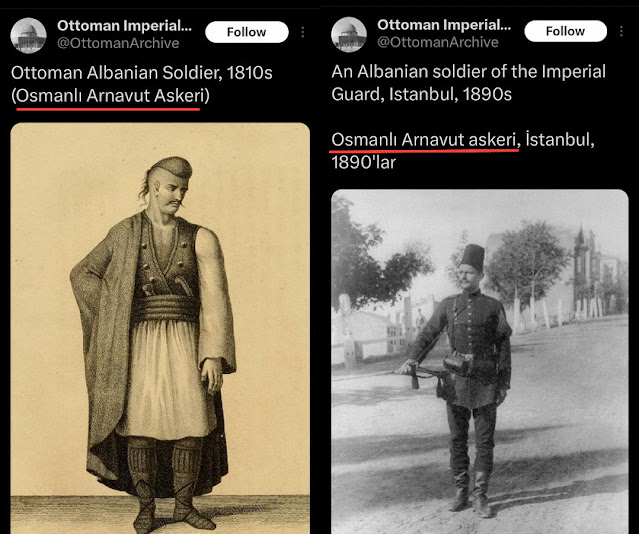The Byzantine Eagle - Shqiponja Dykrenare Bizantine
The Byzantine Double-Headed Eagle is a symbol of the Palaiologos family and dynasty. The two-headed eagle is believed to symbolize the territories of Europe and Asia, all belonging to the Byzantine Empire.
This symbol has been adopted by many European families and by the Albanian state for their flag.
We found the seal of the Andreas Palaiologos family with their double-headed eagle. Andreas was the eldest son of Thomas Palaiologos, Despot of the Morea, while Thomas was a brother of Constantine XI Palaiologos, the Byzantine emperor.
The Palaiologos Family intermarried with the Comneno family that ruled Epirus. They used the same double-headed eagle, and they surrounded it with the Christian Christogram CHI RHO (XP- ΧΡΙΣΤΟΣ -Christ) making it clear that they were believers in Christ. Albanians never mention these symbols that are found even in ancient architecture in Epirus.
The Comneno Family Double headed Eagle with the Christian CHI RHO symbol surrounding it. In the middle is the flag of Greece.
(Shqiponja dykrenare Bizantine është një simbol i familjes dhe dinastisë Palaiologos. Shqiponja me dy koka besohet se simbolizon territoret e Evropës dhe Azisë, të gjitha që i përkasin Perandorisë Bizantine.
Ky simbol është përvetësuar nga shumë familje Evropiane dhe nga shteti Shqiptar për flamurin e tyre Shqiponja e Paleologeve eshte e rrethuar nga Christogramin CHI RHO qe nuk u ruajt nga Shteti Shqiptar )
Members of the Palaiologoi family in Italy, used the symbol of the double-headed eagle for their crown as well.
(Anëtarët e familjes Palaiologoi në Itali, përdorën simbolin e shqiponjës dykrenare edhe për stemen e tyre.)
Lascaris family intermarried with Comnenos and Paleologos had their double-headed eagle as a crown of their family. They also used the Christogram CHI RHO.
(Familja Lascaris e ndermartuar me Comnenos dhe Paleologos kishin shqiponjën dykrenare si kurorë të familjes së tyre. Ata gjithashtu përdorën Christogram CHI RHO)
The double-headed eagle, adopted and inherited from the Paleologus family, remained the Coat of Arms of the Ecumenical Patriarchate of Constantinople.
(Shqiponja dykrenare, e adoptuar dhe e trashëguar nga familja Paleologus, mbeti Stema e Patriarkanës Ekumenike të Kostandinopojës.)
Theodorus Palaeologus, one of the last descendants of the family, was a Lieutenant Colonel in the Parliamentary army and fought at the battle of Edgehill during the English Civil War. At his tomb, he has a double-headed eagle, the crown of the Palaeologus family.
The double-headed eagle, the Constantine the Great eagle was adopted by the families of the Kings of England who had relationship to Greeks.
(Theodorus Palaeologus, një nga pasardhësit e fundit të familjes, ishte nënkolonel në ushtrinë parlamentare dhe luftoi në betejën e Edgehill gjatë Luftës Civile Angleze. Në varrin e tij, ai ka një shqiponjë dykrenore, kurorën e familjes Paleologus.
Shqiponja dykrenore, shqiponja e Kostandinit të Madh u adoptua nga familjet e mbretërve të Anglisë që kishin lidhje me Grekët)
Byzantine Eagle in Epirus was discovered at Rodoni Cape, which is located near Kruja former Antigonea or Eridea. Skanderbeg built castles at Rodoni and Kruja to fight the Turks.
(Shqiponja Bizantine në Epir u zbulua në Kepin e Rodonit, i cili ndodhet pranë Krujës, ish Antigonea ose Eridea. Skënderbeu ndërtoi kështjella në Rodoni dhe Krujë për të luftuar Turqit)
The crown of the Kastrioti, Castriotorum family, was a Byzantine Eagle because the Scanderbeg family intermarried with the Byzantine Families and he was partly Greek himself. His wife was from the Comneno family. Epirotes are Royalty.
(Kurora e familjes Kastrioti, Castriotorum, ishte një shqiponjë Bizantine, sepse familja Skënderbeu u martua me familjet Bizantine dhe ai ishte pjesërisht Grek. Gruaja e tij ishte nga familja Komneno. Epirotët ishin pjesetare te familjeve mbretërore dhe artistokrate)
Kings of Epirus, and Epirote Royalty used the double-headed eagle in their crowns. The eagle was called Bicipite Aquila ( Double headed)
(Mbretërit e Epirit dhe Mbretëria Epirote përdorën shqiponjën dykrenare në kurorat e tyre. Shqiponja quhej Bicipite Aquila (Dykrenare)
This is the Himara flag with the double-headed eagle of 1914. Shqiponja dykrenare e Himares- viti 1914. Shqiptaret Musuilmane e zune ta shkaterronin. Greket e ruajten
Siper Labaro me Kater Kryqe te kuq dhe Shqiponja Bizantine nga Epiri.
Epirotes used the double-headed eagle in their outfits and followed what their Kings were wearing. - Epirotet e perdoren Shqiponjen me dy koka ne rrobat e tyre sepse dhe mbreterit e tyre e vishnin ate ne rrobat e tyre.
The double-headed eagle is found in many artifacts at the Jewish Museum of Greece.
The double headed eagle is seen in Greek Macedonia over Scopje.
A map of the year 1339 by Dulcert shows the Greek flag and the Byzantine double-headed eagle on a flag over the city of Scopie. I had to magnify it. You can see the words Graecia,Filipi, Macedon and Scopie.
(Shqiponja dykrenare gjendet në shumë objekte në Muzeun Hebraik të Greqisë.
Shqiponja dykrenare shihet në Maqedoninë Greke mbi Shkup.
Një hartë e vitit 1339 nga Dulcert tregon flamurin Grek dhe shqiponjën dykrenare Bizantine në një flamur mbi qytetin Scopie. Më duhej ta zmadhoja. Ju mund të shihni fjalët Graecia, Filipi, Macedon dhe Scopie"
Albanians did not use the double headed eagle but the Roman eagle.
Year 1905. Vittorio Betteloni, an aristocrat, poet, and translator of Lord Byron's works, was fascinated with Epirus. He went hunting for Wild Boars in Valona.with Albanians and Turks. The Albanian interpreter is working for him is wearing a hat with the Roman eagle.
(Shqiptarët nuk përdornin shqiponjën dykrenare por shqiponjën romake.Viti 1905. Vittorio Betteloni, një aristokrat, poet dhe përkthyes i veprave të Lord Bajronit, ishte i magjepsur pas Epirit. Shkoi për të gjuajtur për derrat e egër në Vlorë.me shqiptarë dhe turq. Përkthyesi shqiptar që punon për të, mban një kapele me Shqiponjën Romake)


















